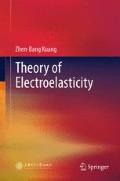Abstract
In this chapter failure experiments and theories in piezoelectric materials are discussed. In present time the precision of experiments should still be improved. The failure theory in solids is very complicated and there is no unified critical criterion. It is clear that the critical energy for different failure version is different. Especially the version of brittle tension failure is significantly different with other versions. In piezoelectric ceramics the failure energy density of an electric field is much higher than that in mechanical loading. In this chapter the generalized stress intensity factor criterions; total, mechanical, and local energy release rate criterions; strain energy density factor criterion; modal strain energy density factor theory; small-scale domain switching theory; failure criterion of conductive cracks with charge-free zone model are studied. Some simple electric breakdown theories of solid dielectrics are also discussed.
Access this chapter
Tax calculation will be finalised at checkout
Purchases are for personal use only
References
Arramon YP, Mchrabadi MM, Martin DW, Cowin SC (2000) A multi-dimensional anisotropic strength criterion based on Kelvin modes. Int J Solids Struct 37:2915–2935
Beom HG, Kim YH (2008) Application of J integral to breakdown analysis of a dielectric material. Int J Solids Struct 45:6045–6055
Budiansky B, Hutchinson JW, Lambropoulos JC (1983) Continuum theory of dilatant transformation toughening in ceramics. Int J Solids Struct 19:337–355
Chen ST (1984) New concepts of elasticity theory and an application. Acta Mech Sin 16:259–274 (in Chinese)
Eshelby JD (1957) The determination of the elastic field of an ellipsoidal inclusion, and related problems. Proc R Soc Lond A 241:376–396
Fang D, Liu B, Hwang K (1999) Energy analysis on fracture of ferroelectric ceramics. Int J Fract 100:401–408
Fang D, Zhang Z, Soh AK, Lee KL (2004) Fracture criteria of piezoelectric ceramics with defects. Mech Mater 36:917–928
Fu R, Zhang TY (2000) Influences of temperature and electric field on the bending strength of lead zirconate titanate ceramics. Acta Mater 48:1729–1740
Fulton CC, Gao H (1997) Electrical nonlinearity in fracture of piezoelectric ceramics. Appl Mech Rev 50:556–563
Gao HJ, Zhang TY, Tong P (1997) Local and global energy release rates for an electrically yielded crack in a piezoelectric ceramic. J Mech Phys Solids 45:491–510
Griffith AA (1921) The phenomena of rupture and flow in solids. Phil Trans R Soc Lond A 221:163–197
Heyer V, Schneider GA, Balke H, Drescher J, Bahr HA (1998) A fracture criterion for conducting cracks in homogeneously poled PZT-PIC151 ceramics. Acta Mater 46:6615–6622
Huang Z-Y, Kuang Z-B (2003) On the influence of the switching wake on the facture toughness of ferroelectric materials. Smart Mater Struct 12:1017–1022
Hwang SC, Lynch CS, McMeeking RM (1995) Ferroelectric/ferroelastic interactions and a polarization switching model. Acta Metall Mater 43:2073–2084
Jiang LZ, Sun CT (2001) Analysis of indentation cracking in piezoceramics. Int J Solids Struct 38:1903–11918
Kuang Z-B (2011) Theory of electroelasticity. Shanghai Jiaotong University Press, Shanghai (in Chinese)
Kuang Z-B, Gu H-C, Li Z-H (1998) The mechanical behavior of materials. Higher Education Publishing House, Beijing (in Chinese)
Kuang Z-B, Zhou Z-D, Chen Y, Zhao S-X (2003) Eigen-material constants, mode and failure criterion for piezoelectric media. Int J Appl Electromagn Mech 18:235–250
Majumdar BS, Burns SJ (1983) A Griffith crack shielded by a dislocation pile-up. Int J Fract 21:229–240
McCmeeking RM, Evans AG (1982) Mechanics of transformation-toughening in brittle materials. J Am Ceram Soc 65:242–246
Ohr SM (1985) An electron microscope study of crack tip deformation and its impact on the dislocation theory of fracture. Mater Sci Eng 72:1–35
Park S, Sun CT (1995) Fracture criteria for piezoelectric ceramics. J Am Ceram Soc 78:1475–1480
Rajapakse RKND, Zeng X (2001) Toughening of conducting cracks due to domain switching. Acta Mater 49:877–885
Ruhlevskii Y (1984) On Hooke’s law. Appl Math Mech 48:420–435 (in Russian); РыхлевскийЯ. ОзаконеГука, прикладнаяматемат и каимехника 48:420–435 (1984)
Shen S-P, Nishioka T (2000) Fracture of piezoelectric materials: energy density criterion. Theor Appl Fract Mech 33:57–65
Sih GC (1973) Some basic problems in fracture mechanics and new concepts. J Eng Fract Mech 5:365–377
Stratton JA (1941) Electromagnetic theory. McGraw-Hill, New York
Suo Z (1993) Models for breakdown-resistant dielectric and ferroelectric ceramics. J Mech Phys Solids 41:1155–1176
Suo Z, Kuo CM, Barnett DM, Willis JR (1992) Fracture mechanics for piezoelectric ceramics. J Mech Phys Solids 40:739–765
Wang T-C (2000) Analysis of strip electric saturation model of crack problem in piezoelectric materials. Int J Solids Struct 37:6031–6049
Wang H, Singh RN (1997) Crack propagation in piezoelectric ceramics: effects of applied electric fields. J Appl Phys 81:7471–7479
Yang W, Zhu T (1998) Switch-toughening of ferroelectrics subjected to electric fields. J Mech Phys Solids 46:291–311
Zeller HR, Schneider WR (1984) Electrofracture mechanics of dielectric aging. J Appl Phys 56:455–459
Zeng X, Rajapakse RKND (2001) Domain switching induced fracture toughness variation in ferroelectrics. Smart Mater Struct 10:203–211
Zhang TY, Wang T, Zhao M (2003) Failure behavior and failure criterion of conductive cracks (deep notches) in thermally depoled PZT-4 ceramics. Acta Mater 51:4881–4895
Zhang TY, Zhao M, Liu G (2004) Failure behavior and failure criterion of conductive cracks (deep notches) in piezoelectric ceramics, I-the charge-free zone model. Acta Mater 52:2013–2024; II-experimental verification. Acta Mater 52:2025–2035 (2004)
Zhu T, Yang W (1997) Toughness variation of ferroelectrics by polarization switch under nonuniform electric field. Acta Mater 45:4695–4702
Zuo J-Z, Sih GC (2000) Energy density theory formulation and interpretation of cracking behavior for piezoelectric ceramics. Theor Appl Fract Mech 34:17–33
Author information
Authors and Affiliations
Rights and permissions
Copyright information
© 2014 Shanghai Jiao Tong University Press, Shanghai and Springer-Verlag Berlin Heidelberg
About this chapter
Cite this chapter
Kuang, ZB. (2014). Failure Theories of Piezoelectric Materials. In: Theory of Electroelasticity. Springer, Berlin, Heidelberg. https://doi.org/10.1007/978-3-642-36291-0_8
Download citation
DOI: https://doi.org/10.1007/978-3-642-36291-0_8
Published:
Publisher Name: Springer, Berlin, Heidelberg
Print ISBN: 978-3-642-36290-3
Online ISBN: 978-3-642-36291-0
eBook Packages: EngineeringEngineering (R0)

